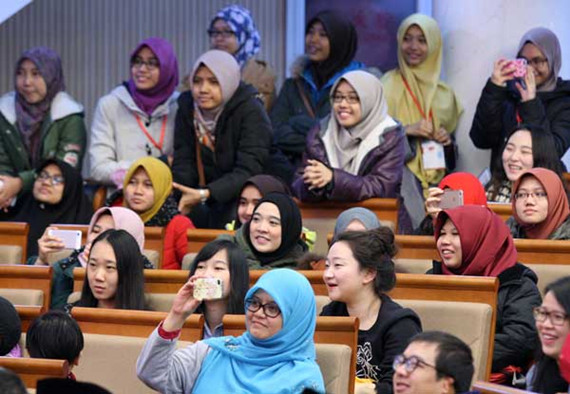
Students from Malaysia and China watch a performance during a Malaysian cultural festival organized by the Beijing Foreign Studies University in November. WANG ZHUANGFEI / CHINA DAILY
The country is planning to overhaul the university system to attract larger numbers of foreign applicants
In 2014, more than 377,000 students from 203 countries studied in China, according to the Ministry of Education. The Institute of International Education calculated the number of foreign students as 356,499, and ranked the country as the third-largest host of international students after the United States and the United Kingdom.
Whatever the true number, in the eyes of Fang Jun, deputy director of the Ministry of Education's Department of International Cooperation and Exchange, the statistics don't tell the whole picture. Although the numbers proclaim China as the world's third most-popular location for students from overseas, factors such as the middling quality of the education provided and the sources and structure of the international student group need urgent review and updating, he said.
Judging by the numbers alone, China has made great progress in the provision of education for international students in the past four decades. In 1978, about 1,900 international students studied in China, but by 2014 that number had risen more than 200 times. Currently, about 2,500 universities offer places to international students, while in 1990 only about 100 universities were allowed to recruit students from overseas.
Fang said the sector is unbalanced because most international students study arts-based subjects, especially Chinese language, and those studying sciences, engineering and business account for a small proportion of the total.
Another imbalance is the low number of students studying at degree level or higher. Only 44 percent of international students come to China to study for a degree. The others are on short-term study programs, many as exchange students who stay for a semester or two before returning to their countries to study for a degree. The situation is the reverse of those in the U.S. and UK, where degree students account for the majority of the international group.
In addition, rather than coming from a wide range of countries, most of the overseas students pursuing degrees in China are from concentrated regions, with more than 70 percent hailing from neighboring countries in Asia or from the African continent.
"Efforts need to be made to diversify the sources and types of international students coming to study in China," Fang said.


















































